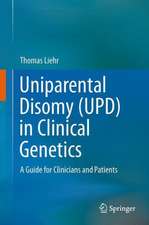Nuclear Receptors: From Structure to the Clinic
Editat de Iain J. McEwan, Raj Kumaren Limba Engleză Paperback – 22 oct 2016
The nuclear receptor superfamily, including receptors for steroid hormones and non-steroid ligands, are pivotal to normal physiology, regulating processes as diverse as reproduction, metabolism, the immune system and brain development. The first members of the family were cloned over 25 years ago, which heralded in the idea of a superfamily of intracellular receptor proteins that bound small molecule ligands: classical steroid hormones, vitamins, fatty acids and other products of metabolism. These signals are then transmitted through multiprotein receptor-DNA complexes, leading to the regulation of target genes, often in a cell-selective manner. The cloning of the receptor cDNAs also ushered in an era of unparalleled analysis of the mechanisms of action of these ligand-activated transcription factors.
| Toate formatele și edițiile | Preț | Express |
|---|---|---|
| Paperback (1) | 713.18 lei 6-8 săpt. | |
| Springer International Publishing – 22 oct 2016 | 713.18 lei 6-8 săpt. | |
| Hardback (1) | 720.10 lei 6-8 săpt. | |
| Springer International Publishing – 29 aug 2015 | 720.10 lei 6-8 săpt. |
Preț: 713.18 lei
Preț vechi: 750.72 lei
-5% Nou
Puncte Express: 1070
Preț estimativ în valută:
136.47€ • 143.50$ • 112.76£
136.47€ • 143.50$ • 112.76£
Carte tipărită la comandă
Livrare economică 17 aprilie-01 mai
Preluare comenzi: 021 569.72.76
Specificații
ISBN-13: 9783319371283
ISBN-10: 3319371282
Pagini: 236
Ilustrații: XI, 236 p. 43 illus., 33 illus. in color.
Dimensiuni: 155 x 235 mm
Greutate: 0.35 kg
Ediția:Softcover reprint of the original 1st ed. 2015
Editura: Springer International Publishing
Colecția Springer
Locul publicării:Cham, Switzerland
ISBN-10: 3319371282
Pagini: 236
Ilustrații: XI, 236 p. 43 illus., 33 illus. in color.
Dimensiuni: 155 x 235 mm
Greutate: 0.35 kg
Ediția:Softcover reprint of the original 1st ed. 2015
Editura: Springer International Publishing
Colecția Springer
Locul publicării:Cham, Switzerland
Cuprins
1. Twenty-five Years of Nuclear Receptor Structure Analysis: From the Laboratory to the Clinic.- Part A. ALLOSTERIC REGULATION AND NUCLEAR RECEPTOR COMPLEX DYNAMICS. -2. Corticosteroid Receptors.- 3. Glucocorticoid Receptor Structure and Function.- 4. What Determines the Difference in DNA Binding Between the Androgen and the Glucocorticoid Receptors?.- 5. Allosteric Regulation and Intrinsic Disorder in Nuclear Hormone Receptors.- 6. Structural Analyses of Ordered and Disordered Regions in Ecdysteroid Receptor.- 7. Structural Analysis of Heterodimeric Nuclear Receptors.- Part B. NUCLEAR RECEPTOR CO-REGULATORY PROTEIN INTERACTIONS.- 8. Primate-specific Multi-functional Androgen Receptor Coregulator and Proto-oncogene Melanoma Antigen-A11 (MAGE-A11).- 9. Assembly and Regulation of Nuclear Receptor Corepressor Complexes.- Part C. TAKING NUCLEAR RECEPTOR STRUCTURE INTO THE CLINIC.- 10. Thinking Outside the Box: Alternative Binding Sites in the Ligand Binding Domain of Nuclear Receptors.-11. Selective Estrogen Receptor Modulators (SERMs) and Selective Androgen Receptor Modulators (SARMs).
Recenzii
“Given the rapid advances in the field of nuclearreceptor research, especially their role in cell proliferation, metabolism, andhomeostasis, which make them prime targets for a wide range of diseases such ascancer and metabolic diseases, this book does an excellent job of coveringtheir structure and function and translational opportunities for drugdiscovery. … The book targets students, scientists, and other clinicians suchas oncologists and endocrinologists interested in the field of nuclearreceptors.” (Omer Iqbal, Doody’s Book Reviews, October, 2015)
Textul de pe ultima copertă
Nuclear Receptors focuses on the structural analysis of nuclear receptors from the initial work using isolated protein domains to the more recent exciting developments investigating the conformational shape of full-length receptor complexes. The book also reviews the structure of key nuclear receptor co-regulatory proteins. The aim is to bring together, for the first time, a comprehensive review of nuclear receptor structure and the importance of receptor conformation underpinning allosteric regulation by different ligands (hormone, drugs, DNA response elements, protein-protein interactions) and receptor activity.
The nuclear receptor superfamily, including receptors for steroid hormones and non-steroid ligands, are pivotal to normal physiology, regulating processes as diverse as reproduction, metabolism, the immune system and brain development. The first members of the family were cloned over 25 years ago, which heralded in the idea of a superfamily of intracellular receptor proteins that bound small molecule ligands: classical steroid hormones, vitamins, fatty acids and other products of metabolism. These signals are then transmitted through multiprotein receptor-DNA complexes, leading to the regulation of target genes, often in a cell-selective manner. The cloning of the receptor cDNAs also ushered in an era of unparalleled analysis of the mechanisms of action of these ligand-activated transcription factors.
The nuclear receptor superfamily, including receptors for steroid hormones and non-steroid ligands, are pivotal to normal physiology, regulating processes as diverse as reproduction, metabolism, the immune system and brain development. The first members of the family were cloned over 25 years ago, which heralded in the idea of a superfamily of intracellular receptor proteins that bound small molecule ligands: classical steroid hormones, vitamins, fatty acids and other products of metabolism. These signals are then transmitted through multiprotein receptor-DNA complexes, leading to the regulation of target genes, often in a cell-selective manner. The cloning of the receptor cDNAs also ushered in an era of unparalleled analysis of the mechanisms of action of these ligand-activated transcription factors.
Caracteristici
This book provides state-of-the-art reviews from key researchers in the field Emphasizes how protein structure is informing a fuller understanding of receptor activity Provides a comprehensive overview on nuclear receptors ? Includes supplementary material: sn.pub/extras



















